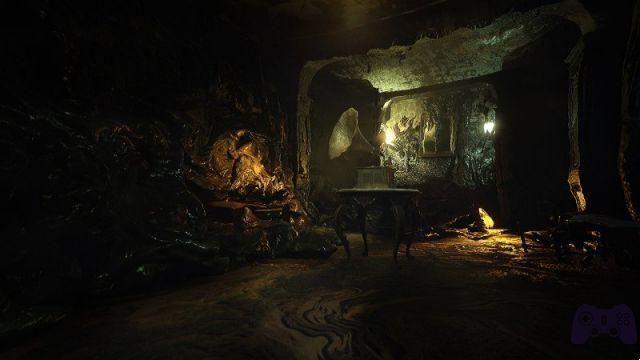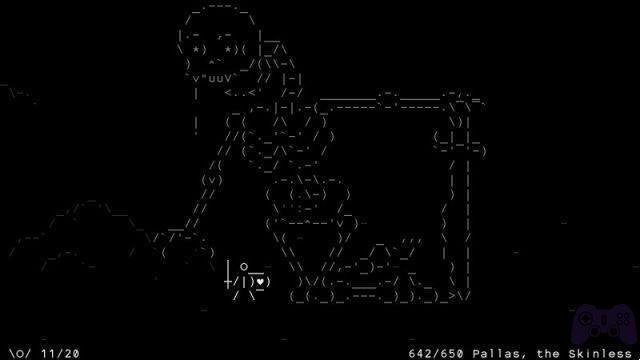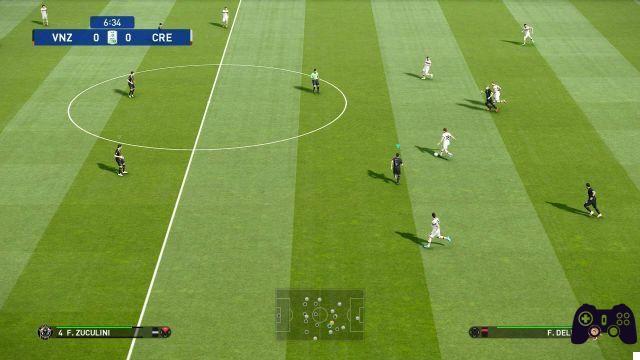It doesn't matter if you love him madly or consider him overrated: FromSoftware It is undoubtedly one of the most influential software houses of the last twenty years. By inventing an ingenious variant of the action role-playing games now known almost everywhere under the name of soulslike, Hidetaka Miyazaki and his team caused a kind of tsunami, capable of showing everyone how much room there is in the video game market for atypical and brutal titles, which influence generations of developers (although not always necessarily for the better...). Many players, however, did not discover this house full of talent until after the arrival of the souls, completely missing out on an eclectic past made up of products often qualitatively removed from their current works.
We, FromSoftware, on the other hand, have followed it from the beginning, starting with those King's Field and Shadow Tower that already contained many of the canons and structures that the good Hidetaka later used in his works, to later immerse ourselves in the strange whirlwind. from the Otogi, from Kuon, from Ninja Blade, and even from that crazy (and hilarious) experiment called Metal Wolf Chaos. In short, FromSoftware really mounted that diversification that to date has only been glimpsed with Sekiro: Shadows Die Twice and Elden Ring like a cowboy riding a rabid bull years ago, with disparate results that only in glimpses showed the real capabilities of the team.
In this primordial video game soup between the incredibly dark and the complete madness, the constant outside of the aforementioned King's Field was one and only one: Armored Core, a sci-fi action series that gave the player the opportunity to freely customize huge combat mechs. Clearly inspired by Gundam and the like, Armored Core were arguably the best titles of FromSoftware's first era, presenting a concept so advanced that it earned "small cult" status in Japan. However, coming from a time when the Japanese company did not even remotely have the current resources, these games never managed to fully exploit their potential, despite a large number of chapters and expansions of more than decent quality. Therefore, it is not necessary to delve too deeply into why, for a fan of the brand, the official launch of Armored Core 6: Fires of Rubicon was a blow to the heart: the skeleton on which the old games are based is a real Wonderful. for lovers of tailor-made experiences in the player; With the experience acquired, such structural goodness can be transformed into something sublime, and without even needing to particularly let go of the roots.
Well, FromSoftware must have sensed all these possibilities, because it took the reins of the new project. Masaru Yamamura, lead designer of Sekiro and undisputed figure of the studio, which for six years tried to find a perfect balance between the necessary evolutions and the quality of its predecessors. Has he succeeded or have the chains of the past been heavier than expected? To understand it and prepare as best we can for it. Armored Core 6: Fires of Rubicon Review, we have spent dozens of hours playing and today we think we are finally ready to tell you if it really is the glorious return of a brand that has always deserved more.
Narrative and structure: freedom in the fire
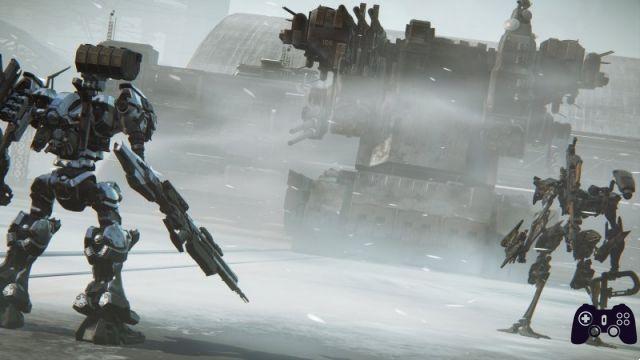
Despite the "six" in the title, FromSoftware's new Armored Core It is not a direct sequel to the previous chapters and represents the starting point of a new timeline in the series. This is not an absolute novelty, let's be clear: although the plots of Armored Core are often quite complicated and built around more detailed universes than ever, several previous chapters have already been created with the intention of introducing new chronologies. That said, don't think for a second that the reboot of the narrative background of Yamamura's work wants to abandon the themes dear to the series... The world of Armored Core 6: Fires of Rubicon is always a dark place dominated by megacorporations. , in which what little humanity is present is often suppressed by the horrors of war and the race for profit, or by dark forces at work behind the scenes. This cynical, cold and sometimes dangerously close vision of possible reality is an integral part of the brand's soul, and it's nice to see it proposed here with renewed vigor. It is true that the tone is similar to that seen in most other FromSoftware productions, so for many it will not be new, however a change remains with respect to other works from the house: the story is pretty clear and, in the end, only a handful of dark points remain, not so fundamental to understanding its progress.
Armored Core 6, after all, is a work led by Yamamura and not by Miyazaki, and already in Sekiro his tendency to leave fewer doubts was noted, presenting the events in a more classic and simple way. The break with Miyazaki and his work in the series, however, is less clear than one might think, because here the structure of Armored Core For Answer is almost completely taken up, to the point that, to obtain all the endings and have the business suit frame available, you need to finish the campaign three times.
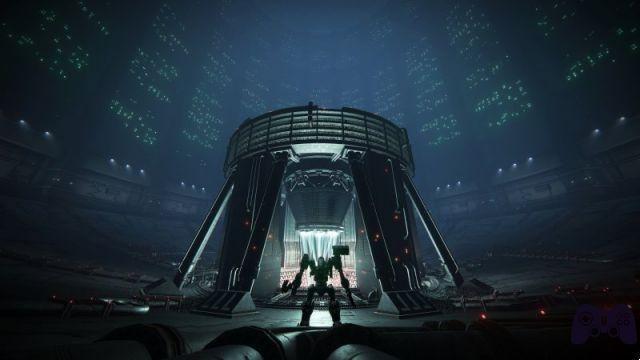
It is better to go into more details. Armored core It is not an open world or macro zone game.; After a rather scenic prologue, you will become mercenaries in every aspect guided by the voice of your supervisor, Walter, in the choice of the different missions proposed from chapter to chapter. These missions in older episodes tended to last a matter of minutes, with Armored Core V and Verdict Day being the only exceptions (and not even always); Therefore, the team's choice was to mix up the cards a bit with much more varied tasks this time, and a combination of extremely fast missions and more elaborate events. It's a choice we sincerely approve, because the most basic missions are a good testbed to experiment with your mech's performance or run some tests, while the more refined and complex ones also clearly show the difference compared to previous chapters. as surprising more because of the alternation. The solution adopted, however, presents some problems, to which we will return when we enter into the debate on the difficulty.
But let's return to the repeated campaigns, because here lies both one of the most fascinating elements of the game and at the same time one of the most difficult to digest for those who are not familiar with the saga. Basically Armored Core 6 has three different endings, but they cannot be obtained in a single attempt, also because it is not possible to save them manually. The closure of the campaign is decided after a series of forced choices, which prevent specific missions from being completed in the next game; Tackling them all leads to unlocking a series of new key events on the third run, which then allow you to get an additional final act. It's certainly not the most intuitive structure in the world, but it works because it's able to amplify the positive aspects of For Answer: getting new parts for your robot makes it nice to approach levels again in a different way, and its length prevents things become too tedious; At the same time, each new mission or variation found on pre-existing tasks (yes, some change even while you're tackling them) is a pleasant surprise, capable of adding just enough flavor to the experience. It is also thanks to this solution that Only some of the main missions take place on large maps and require checkpoints.: If redoing them took eons, the experience would become excessively slow, so it was smart not to abandon synchronization of the old chapters. To liven things up a bit is the return of arena battles, in which the player participates in fighting other AI-controlled mechs in various configurations. It's certainly not groundbreaking, but it breaks the pace a bit, has its own surprises during subsequent runs, and is connected to very important systems in the game, so it's hard not to appreciate its presence.
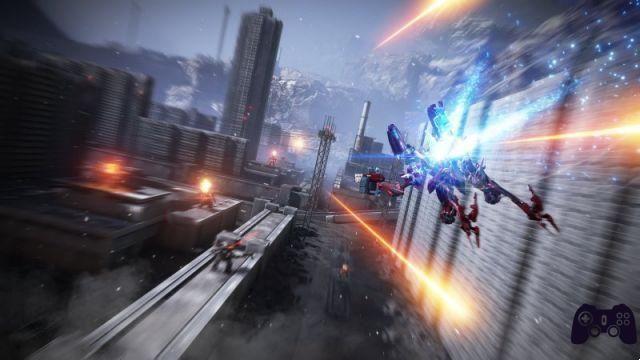
But be careful, defending what has been done and understanding the desire not to stray too far from the basic skeleton of the saga, an experience of this type always suffers from a bit of tedium. On the one hand, it is true that in Armored Core perfecting yourself by repeating the different missions until you reach a perfect score everywhere is an integral part of the fun, but not everyone who takes on this game is necessarily a veteran of the series, and even for For experts, having to start from scratch several times with the boss can be annoying, also because Rubicon is full of typical traps of "FromSoftware games" and there is no shortage of infamy. Furthermore the punctuation in the various events, it is not awarded until you repeat them manually from the menu, an illogical solution that forces perfectionists to have to redo some missions a minimum of four times to obtain a final "S" grade. Manual saving and a little more openness in these aspects would surely have improved things, even if they shortened them. In general, however, we are faced with a title that, on average, is longer than its predecessors, but far from the length of souls. All three races can be completed without too many problems. between 20 and 25 hours, even if times may decrease or increase significantly depending on how long it will take you to overcome some of the difficulty "walls" present.
Gameplay: War Engineering
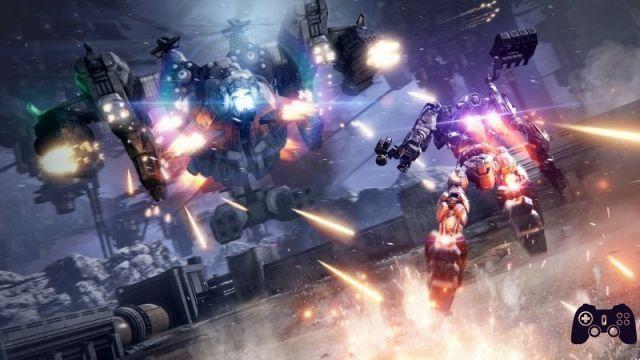
The main reason why the ups and downs of the structure are not particularly boring is, unsurprisingly, the game of the game. The heart of Armored Core, after all, has always been assembly, that is, the possibility of completely changing the approach based on the changes made to your robot, through an increasing number of parts and weapons. Obtainable as you progress through the campaign. It is the backbone of the series, what distinguishes it above all, has made it a cult medium and has always made its fans turn a blind eye to the many defects of the past, so it is good and right that in this chapter this constituent primary is more central than ever to the experience.
Furthermore, it is not at all underestimable that the new proposal for this core of the game has been so successful at FromSoftware: customization is indeed one of the most fun and central parts, but it is also one of the least intuitive and most complex to understand; Many of the past games overwhelm the user with a sea of data and parts whose functions are barely explained, to the point that the difficulty of learning has led many over the years to not even try to approach the saga. . Several episodes, for example, do not even contain anything that can be defined as a tutorial, only to underline how little the house cared about making its productions "readable" at that time. Yamamura had to do a design balancing act regarding this aspect; On the one hand, I couldn't oversimplify because of the risk of infuriating fans by simplifying the systems, while on the other, it wouldn't have made sense not to worry about accessibility in a game that represents a new departure for the series. The director's response? Eliminate excess, pushing the effect that each choice has on the game to the limit. In Armored Core 6, in fact, more than ever objectives and bosses require tactical solutions and intelligent decisions when building your mech, also due to the increased difficulty and the inclusion of some new and interesting mechanics. Additionally, there are tutorials here that allow you to try out various mechanical setups, giving at least an idea of the differences and possible applications.
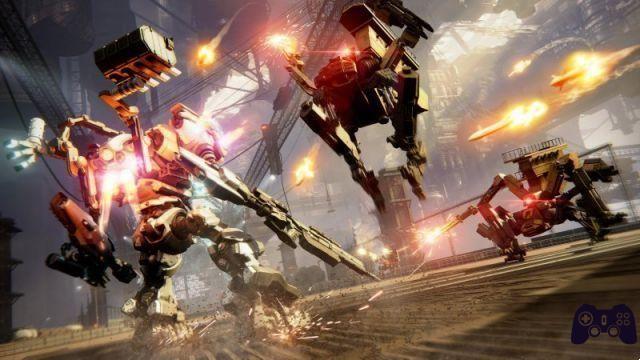
Precisely on this last point, however, the new Armored has made a discrete leap in quality: although with fewer types of components to juggle If you consider the other titles (there are no radiators to overheat, no radar, no weights to change the robot's balance), each choice tends to influence the response to your metal warrior's commands much more clearly. The legs, in particular, have a more marked influence on movement: crawlers are capable of performing very fast maneuvers on the ground but very limited in any other situation, quadrupeds capable of floating in the air consuming little energy, and legs with inverted joints equipped with the ability to make sudden jumps (and therefore especially suitable for those who love to dodge).
It may seem silly to say this, but keep in mind that this is a game with three-dimensional movement, in which the bosses have been tweaked to be much more evil than in the past, as well as capable of putting even a highly armed mech in difficulty. to the teeth. His movement capacity Therefore, they are tremendously important in battle: being able to float smoothly makes bosses with low elevation and attacks aimed primarily at the ground trivial, while high acceleration at low altitude allows you to instantly close in on particularly annoying enemies from distances. socks. It's not enough, three other new elements have made the boss battles more brutal and frenetic than in the origins: the presence of a stability bar, the ability to use four weapons at the same time and fixed objectives.
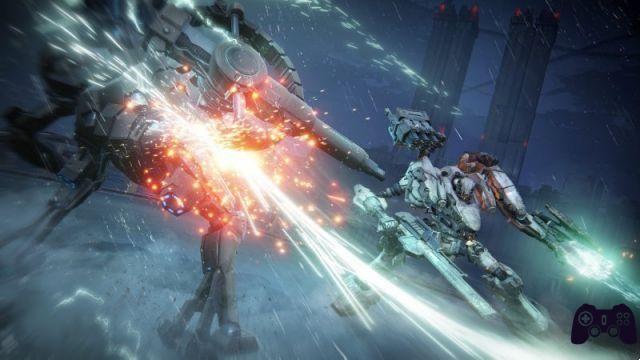
Let's start with stability, and no, it is not a resistance variant, since in Armored Core the equivalent of the latter is energy use and that depends on other factors (mainly the choice of a suitable generator); Stability is effectively a gauge that rises when hitting (or being hit by) the opponent, and if pushed to the limit stuns for a few moments, allowing greater damage to be inflicted for a short period. However, don't think that the mere presence of a similar feature makes the game weak and defensive, because, in fact, combinations of four weapons can now be used simultaneously, with each instrument linked to a specific dorsal trigger; The new Armored is therefore very aggressive, and establishing the best speed, the effective impact of the projectiles, the validity of the combinations and the shooting distance is really important to cause serious damage.
Here too, for example, there are elements taken from previous chapters, because, as on Verdict Day, the types of damage they affect enemy defenses differently (even if everything was handled infinitely worse in that game). Carefully selecting whether to use laser or plasma weapons, focusing everything on bullets and explosives, or launching into a balanced mix makes the difference between quick elimination of obstacles and an early death. In our opinion, this combination of factors is brilliantly implemented, because the need to stun enemies and the importance of selecting each weapon significantly increase tactics in battle. Additionally, to encourage variations, before each boss there is usually a checkpoint where you can freely change the design of your mech (provided you have purchased the parts, as they can only be purchased in the garage). It's very clear how the experience of Sekiro led the director to manage difficulty with a similar approach: if a battle is difficult it cannot be overcome by accumulating experience, but it can be made very easy by finding the right keystone; This is a philosophy that fits perfectly with the Armored Core series and shows that choosing Yamamura to take the reins of the project was a great step.
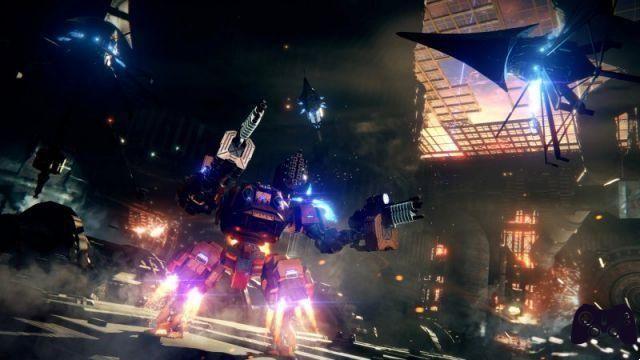
However, as we mentioned, in this game the bosses have changed considerably, and even the basic enemies tend to have much more variety - although they are still generally easy to eliminate - however, to implement more varied and dangerous offensive patterns, the team ha I had to take an element from the latest games developed: the fixed orientation. Initially seen almost as a blasphemy by series veterans, however, this novelty is not so apocalyptic as to completely transform the experience, on the contrary. Yamamura was clear: the ability to keep your sights locked on the target was inserted precisely to allow players Focus on your robot's movements., due to the evolution of patterns; However, if you think that it is enough to place the target on the enemy and shoot at random, you are wrong, because there are many subtleties related to aiming. Fixed aim and effective aim, for example, are not the same: weapons do not track the enemy as fast as the camera, so shooting at a distance against enemies with fixed aim results in a large number of missed shots. . To improve accuracy, you must select a component called FCS accurately (affects distance tracking, even for melee weapons) and using "semi-automatic" aiming by manually moving the camera significantly increases hits. Furthermore, only for true experts, it is even possible to select a completely manual objective, but we assure you that it is no small feat to manage it properly given the variety and speed of movements in the game. Ah, for the record, the woody aspect of the old Armored control system has almost completely disappeared here; Controlling the robot is a real pleasure, the response to commands is precise and appropriate to the components chosen, and we don't think there has ever been a title in the series so fun to play. A great evolution.
Difficulty and progression: the main cure
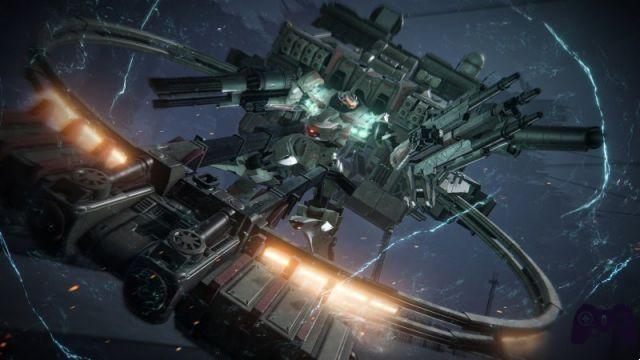
If what has been done mechanically in the game is, in our opinion, almost impeccable, the same cannot be said for the game. difficulty curve management. We've already touched on this, talking about the tactical approach to bosses and the importance of assembly, but the fact that the challenge level is a little off is unfortunately quite evident, perhaps even more markedly than in other recent FromSoftware productions ( There have always been important changes here and there). The aspect that makes the perception of difficulty chaotic is, in a certain way, precisely the attachment to the past structures of the series, which led From to propose quick and simple missions, and almost suddenly to alternate them with bad bosses, with cuts that increase. later in the races after the first (in which the new missions tend to be more difficult than the original ones). It is not a particularly serious situation, and we do not believe that it causes real suffering, but it must be said that it exists in the countryside. a specific and inevitable boss which will present a scary wall for many players, especially newbies with little building experience. Mind you, even that boss becomes very doable with the right strategy... it's just undeniable that compared to what was faced before, it's a somewhat randomly calculated spike, which could have been introduced with some additional clues about the strategies to follow. . Arena mode, meanwhile, doesn't counter things at all, as while it also contains secret battles, it's still incredibly easy from start to finish, and only serves as training for specific battles against multiple mechs at once.
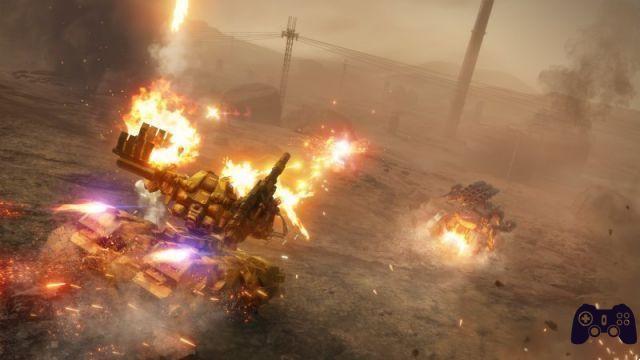
Then think about amplifying the changes even more. the progression system- Although it lacks level progression, Armored Core 6 still allows you to upgrade your mech even separately from the chosen parts, a bit like what happened with the "tuning" of Armored Core 4 and For Answer. By fighting in the arena you will obtain passive damage and defense bonuses through the call Operating System, and also the possibility of customizing your playing style by unlocking additional maneuvers or energy powers very useful in combat; On the first run these perks will be limited, and the chips that unlock them will have to be cleverly inserted, but on the third run you will have unlocked all the extras, making the "simple" missions even easier and the already beaten bosses insignificant. . say the least. For God's sake, even these improvements are calculated, mainly for perfectionists eager to get the maximum score in each level, but we think it is quite natural to understand how they cause greater collapses in a game where the level of challenge is no longer the most natural. . However, we understand the desire to include a limited number of kits in "cure" than the game's supply zones - many of the more challenging tasks require you to be economical with bullets and resources, and these additions are well-calculated to get you through them. We even approve of the choice of not being able to have negative debts after levels, and the fact that the sale value of the pieces is the same as the purchase value; They make assembly more flexible and encourage the user to experiment.
Technical and PvP compartment: stainless steel
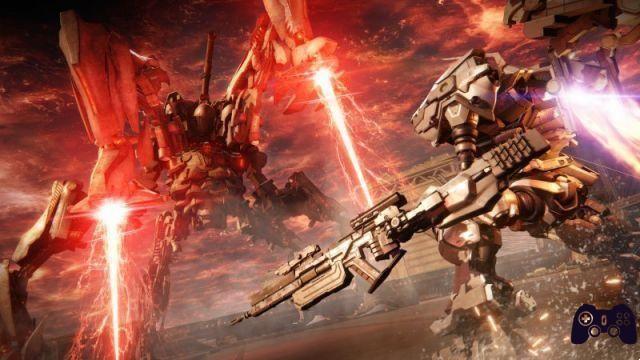
Although there is nothing negative to say about it. technical sector, since FromSoftware seems to have really modified the graphics engine of its games for this Armored Core. On PlayStation 5, where we tested it, the game has always been very smooth, with extremely short loading times and good overall details. We were also pleasantly surprised by the variety of maps and scenarios that, despite not having the impact (and creative freedom) of the house's fantasy games, manage to impress thanks to an art direction always of the highest level. Furthermore, it is not easy to create such good maps considering their size in some phases of the campaign: there are extremely extensive and extraordinarily picturesque settings, which are a far cry from the bare ruins of the previous chapters despite their size. We also think it's great that the look and level of detail of the mechs are still high quality, considering the large number of parts available to modify them. Think about it, it's even possible to change the color of each piece individually and modify them with custom decals that can be placed anywhere, as if to underline once again how important it is to create the robot you've always wanted to pilot.
Notably, although less noticeable due to the player's ability to move freely in three dimensions, the level design; FromSoftware remains an absolute guarantee in this regard. The maps are calculated around objectives, often offer alternative routes to reach the closure, and are also quite rich in secrets, including unique pieces to find while exploring. The invisible barriers that make some areas "compartmentalized" (and sometimes annoying during certain battles) could have been avoided, but we understand the need to limit exploration at times to avoid losing the player. Another evolution that cannot be underestimated? The very clear improvement of enemy hitboxes and the subdivision of impact areas. While in the past some targets were quite ridiculous, to the point that huge buildings could be destroyed by throwing swords randomly at any point in the structure, now it is often necessary to hit well-defined points, protected by armor on which the bullets are projected. bounce mercilessly. This is a technical improvement that directly influences the gameplay and another demonstration of how modern and carefully developed this Armored Core is.
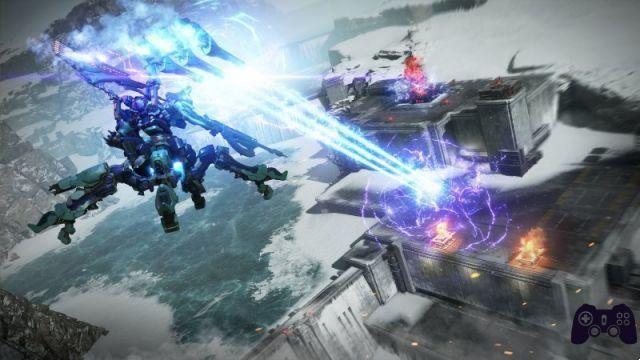
Finally, some doubts about PvP. During our test we were not able to adequately test its stability, but from what we have seen the competitive part of the title offers 1v1 and 3v3 duels that are hilarious to say the least, where choosing the right build is particularly important, and we hope to see combinations and high-level strategies within a few months. The problem is that the mode seems to completely lack online matchmaking: everything is managed through the lobby and, although this choice favors the stability of the online experience (a very widespread problem in FromSoftware productions), at the same time it runs the risk of limiting the spread of PvP only. to gated communities and dedicated sites. We will see if the situation changes at launch or in the future; Overall though, it's an integral part of the series and it's nice to see it implemented once again.
Conclusions
Holygamerz.com 8.5 Readers (79) 7.6 your voteFor a fan of the Armored Core 6 series it is a dream. The work of Yamamura and his team is what Armored Core always had to be, a frenetic action game full of tactics, which offers a level of customization unique in the genre and that gives enormous satisfaction to anyone who wants to delve into it. their systems. The numerous technical evolutions and improvements to the system, however, are partly held back by the desire to stick to old structures that may be repetitive for many, and by a somewhat chaotic difficulty curve, which in our opinion could surely have been calculated better. Overall, it is still a very high quality game, which we recommend without hesitation and represents an absolute must for anyone who has loved the saga in the past. Now let's just hope From continues to carry the brand forward while maintaining this level of quality.
PRO
- The assembly gives enormous satisfaction.
- Fast-paced, fun and tactical game.
- Big improvements to level design and battle variety.
- In all likelihood, it is FromSoftware's most technically advanced game.
AGAINST
- Quite confusing and fluctuating difficulty curve.
- Balance to be evaluated
- Having to repeat the campaign several times could be tedious




